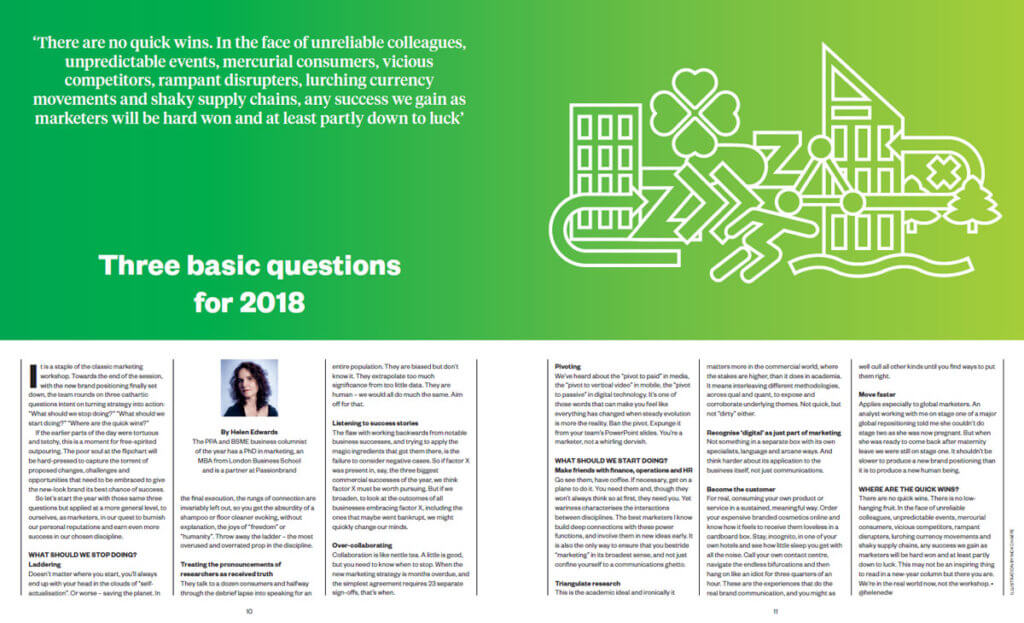Three basic questions for 2018
It is a staple of the classic marketing workshop. Towards the end of the session, with the new brand positioning finally set down, the team rounds on three cathartic questions intent on turning strategy into action: “What should we stop doing?” “What should we start doing?” “Where are the quick wins?”
If the earlier parts of the day were tortuous and tetchy, this is a moment for free-spirited outpouring. The poor soul at the flipchart will be hard-pressed to capture the torrent of proposed changes, challenges and opportunities that need to be embraced to give the new-look brand its best chance of success.
So let’s start the year with those same three questions but applied at a more general level, to ourselves, as marketers, in our quest to burnish our personal reputations and earn even more success in our chosen discipline.
WHAT SHOULD WE STOP DOING?
Laddering
Doesn’t matter where you start, you’ll always end up with your head in the clouds of “self-actualisation”. Or worse – saving the planet. In the final execution, the rungs of connection are invariably left out, so you get the absurdity of a shampoo or floor cleaner evoking, without explanation, the joys of “freedom” or “humanity”. Throw away the ladder – the most overused and overrated prop in the discipline.
Treating the pronouncements of researchers as received truth
They talk to a dozen consumers and halfway through the debrief lapse into speaking for an entire population. They are biased but don’t know it. They extrapolate too much significance from too little data. They are human – we would all do much the same. Aim off for that.
Listening to success stories
The flaw with working backwards from notable business successes, and trying to apply the magic ingredients that got them there, is the failure to consider negative cases. So if factor X was present in, say, the three biggest commercial successes of the year, we think factor X must be worth pursuing. But if we broaden, to look at the outcomes of all businesses embracing factor X, including the ones that maybe went bankrupt, we might quickly change our minds.
Over-collaborating
Collaboration is like nettle tea. A little is good, but you need to know when to stop. When the new marketing strategy is months overdue, and the simplest agreement requires 23 separate sign-offs, that’s when.
Pivoting
We’ve heard about the “pivot to paid” in media, the “pivot to vertical video” in mobile, the “pivot to passive” in digital technology. It’s one of those words that can make you feel like everything has changed when steady evolution is more the reality. Ban the pivot. Expunge it from your team’s PowerPoint slides. You’re a marketer, not a whirling dervish.
 WHAT SHOULD WE START DOING?
WHAT SHOULD WE START DOING?
Make friends with finance, operations and HR
Go see them, have coffee. If necessary, get on a plane to do it. You need them and, though they won’t always think so at first, they need you. Yet wariness characterises the interactions between disciplines. The best marketers I know build deep connections with these power functions, and involve them in new ideas early. It is also the only way to ensure that you bestride “marketing” in its broadest sense, and not just confine yourself to a communications ghetto.
Triangulate research
This is the academic ideal and ironically it matters more in the commercial world, where the stakes are higher, than it does in academia. It means interleaving different methodologies, across qual and quant, to expose and corroborate underlying themes. Not quick, but not “dirty” either.
Recognise ‘digital’ as just part of marketing
Not something in a separate box with its own specialists, language and arcane ways. And think harder about its application to the business itself, not just communications.
Become the customer
For real, consuming your own product or service in a sustained, meaningful way. Order your expensive branded cosmetics online and know how it feels to receive them loveless in a cardboard box. Stay, incognito, in one of your own hotels and see how little sleep you get with all the noise. Call your own contact centre, navigate the endless bifurcations and then hang on like an idiot for three quarters of an hour. These are the experiences that do the real brand communication, and you might as well cull all other kinds until you find ways to put them right.
Move faster
Applies especially to global marketers. An analyst working with me on stage one of a major global repositioning told me she couldn’t do stage two as she was now pregnant. But when she was ready to come back after maternity leave we were still on stage one. It shouldn’t be slower to produce a new brand positioning than it is to produce a new human being.
WHERE ARE THE QUICK WINS?
There are no quick wins. There is no low-hanging fruit. In the face of unreliable colleagues, unpredictable events, mercurial consumers, vicious competitors, rampant disrupters, lurching currency movements and shaky supply chains, any success we gain as marketers will be hard won and at least partly down to luck. This may not be an inspiring thing to read in a new-year column but there you are. We’re in the real world now, not the workshop.
